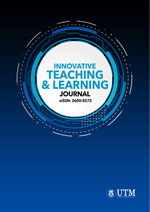Audio-Visual Learning in Secondary School: A Review of Advantages and Challenges in Education
DOI:
https://doi.org/10.11113/itlj.v8.153Keywords:
audio-visual, secondary school, advantages, challenges, educationAbstract
The Industrial Revolution 4.0 (IR) is an impetus for the use of more advance technology in the education setting. Alongside the changes taking place because of it, teachers too need to evolve. As the main player of any teaching and learning session (PdP), their role is not only to modify students’ behaviour but also actualise educational goals. Both of which can be helped with the use of technology-based materials and mediums. Audio media is a media in the form of sound that requires listening abilities, whereas visual media is materials in the form of images or pictures that do not require listening skills but do require viewing skills. The selection of one of these media as a learning medium results in one-way and ineffective listening. On the other hand, audio-visual media is an intermediary media which combines seeing and listening skills that help students acquire knowledge, skills, and attitudes to achieve learning goals. Therefore, this paper will look at the literature review on the potential of audio-visual material-assisted learning in education and explore its advantages and challenges at secondary school level. The review demonstrates the advantages of implementing audio-visual materials in multiple fields of education. Using Boolean search techniques, a literature search was produced from numerous databases while searching for terms related to audio-visual teaching and learning. This study reviewed ten research papers from 2018 to 2022 using a systematic analytical approach to produce a comprehensive analysis based on specific criteria.This study summarizes the advantages and challenges of learning with the help of audio-visual materials. It is reported that the use of audio-visual materials helps to increase students’ motivation, ensure students’ active participation, engage students’ attention, create better learning atmosphere, increase teacher innovation and creativity, and ultimately resulted in increase of learning delivery effectiveness. However, it doesn’t come without a challenge. Preparing such materials is timeconsuming, costly and requires high technical skills which affects teachers’ motivation. As such, this paper can help educators see how the application of audio-visual materials in the educational world benefits students. In addition, educators can also identify challenges or constraints that need to be paid attention to if this material is to be used in PdP in the future.

















